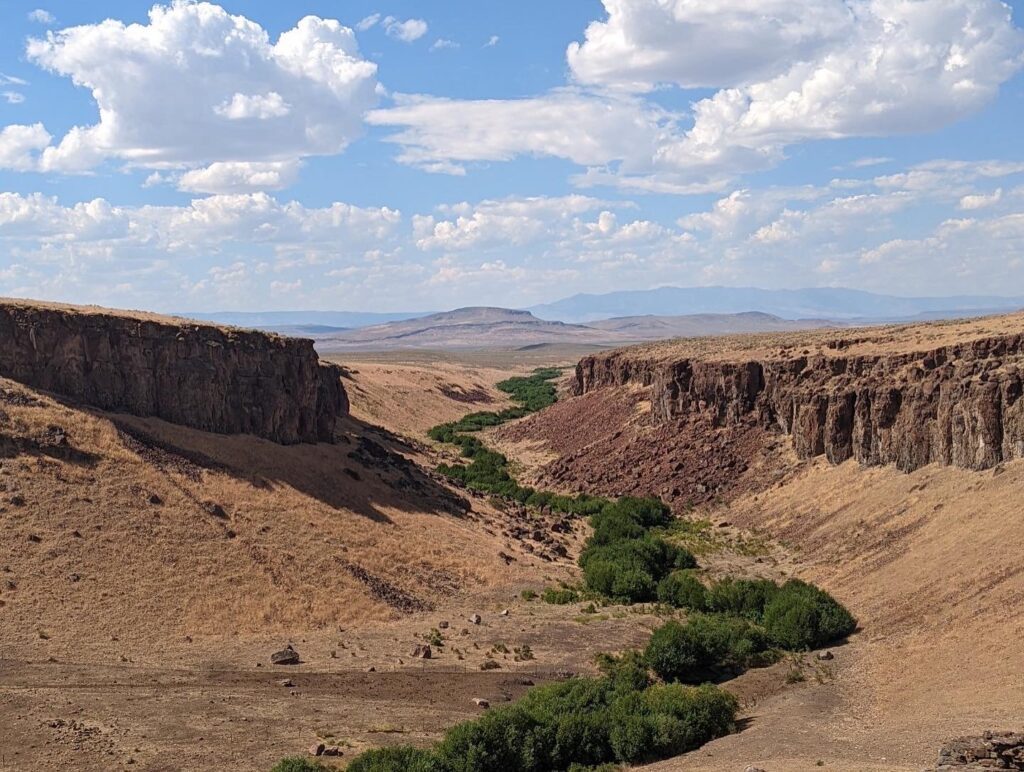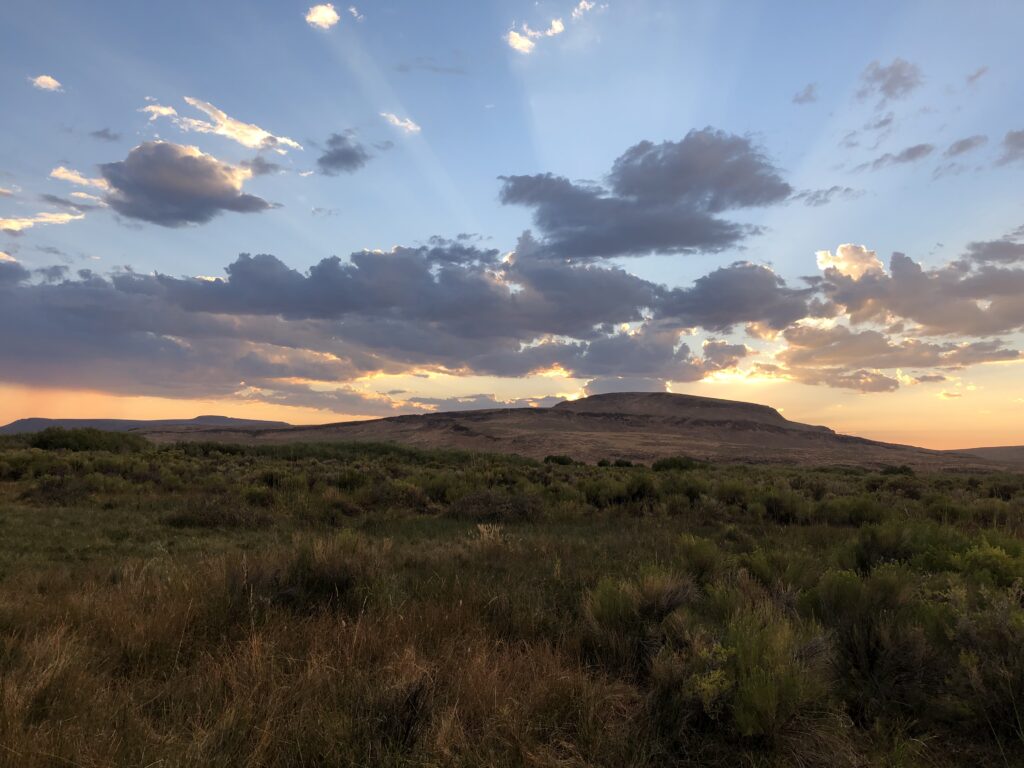These fish had been through it. It was hard to believe anything out here hadn’t been, even without human intervention. The Great Basin is a land of extremes, experiencing massive temperature swings and challenging seasons throughout the year for its wild residents. Throw in the desertification of their home lake and the anthropomorphic uppercuts of cattle, stocking, and climate change, and you’ve got the life on the edge existence of Lahontan cutthroat trout.
The creek we were on and its tributaries flow out of remote mountains and into one of the many sub-basins in this landscape. 12,000 years ago, these streams would have terminated in a massive inland sea, Lake Lahontan, which had a surface area of over 8,000 miles and covered parts of present day Nevada, Oregon, and California. As the last ice age ended and the local climate shifted the lake dried up, breaking into smaller and smaller bodies of water until all that was left were trickles of springs and snowmelt. This change saw the disappearance of other native fauna in the region- camels, cave bears, and saber-toothed cats all vanished in one of history’s biggest extinction events. One of the last guesses as to what would survive the drying up of an entire drainage basin would be its native fish, yet the descendants of Lake Lohontan’s trout still live here, relegated to the remaining waters of their new environment. Hardened by millennia in the desert, they persist in waters that would be fatal to many of the world’s coldwater fish. Naturally unstable flows and drought spells can push water temperatures north of 80 degrees Fahrenheit and restrict fish movement to the refuge of cooler beaver pond outflows and higher gradient sections of stream. Despite all odds, some populations of cutthroat here are strong in these conditions. The minor subspecies we were targeting for the next few days evolved on their own after being separated from the larger Lake Lahontan. They’re native to nowhere else on earth except the few perennial streams that cut through this area.

Fishing the first pond yielded nothing. It was early, but past experiences from a summer fishing some of the high desert’s rarest and most remote trout populations began to haunt my mind. Were we too late in the year? Had the fish finally succumbed to the environmental pressures that had been placed on their water? Would the day’s drive to get here only result in a few productive hours of fishing in the evening and early morning, forcing us to shelter from the heat like the rest of the desert’s native animals? This area had been in a drought for the better part of a decade, and although we had reliable information that we were here at a good time, changing conditions over the past few years may have altered what we thought we knew.
Although the Lahontans of the Great Basin have adapted to thrive in extreme conditions, the subspecies has been listed as threatened by the Endangered Species Act since the early 1990s. Overgrazing of cattle on streams have damaged long stretches of riparian ecosystem, which in turn destabilized riverbanks, decreased water quality, and raised water temperatures. Longer periods of drought and higher temperatures as a result of climate change have decreased snowpack and flows, creating a greater challenge to the survival of these fish through the year. Introduced rainbow trout have spawned with Lahontan populations in many streams, interbreeding the native fish to extinction and creating a hybrid fish with lower fitness for the harsh environment. Restoration efforts over the last decades have provided some relief from the assault on the streams, but it’s clear that long term damage has already been done to much of the Lahontans’ habitat and genetics. According to Trout Unlimited, there are less than 75 populations of these fish left in the Basin, many with their own unique genetics as a result of long term isolation. A much smaller number of these populations are actually stable and have a legitimate future.
Moving to a new section of stream, we began to see signs of life. The riparian zone was more intact here. High banks prevented cattle from getting to the creek, preserving thick vegetation and shade covered water. Stretching my rod out beyond the shrubs and over the water, I heard a splash and set the hook. As the fish thrashed on the surface, I quickly slid down the bank and got it into my net. The fish was sparsely spotted across most of its body, with some heavier markings towards the tail. Its grayish green dorsal side gave way to a deep purple color along its lateral line, with an especially rosy sheen on its gill plate. At barely over six inches, the size of fish I’d expect to see in this type of creek, it was hard to believe that these animals were once rulers of a massive stillwater, and predicted to grow to proportions comparable to their distant relatives in Nevada’s Pyramid Lake. Now, thousands of years later in a totally different climate, I slid one of their descendants back into what remained of its native range. The interaction made me feel even smaller than the cutthroat I had just released.


As the afternoon went on, we pushed into a more remote section of stream. The gradient increased, signs of cattle grazing lessened, and the willows grew thicker. The fishing became more technical, requiring precise bow and arrow casts, dapping a few inches of leader through thick brush, and creeping slowly up to the few open pockets we could make a cast into. The Lahontans, however, were numerous. Soon it seemed that every bend, undercut bank and deeper seam held a few fish, and our hoppers were being smashed in explosions of purple and green. The fish were completely unpressured here, and wise advances were almost always rewarded in an eat.


We began our exit from the canyon we had ventured into. We decided to fish one more section of stream close to where we had made our camp for the night, a lower gradient area with a few beaver ponds that we hoped would fish better in lower light and temperatures. Unfortunately, someone had gotten there before us. A herd of cattle that had spent the afternoon in the creek spooked out onto the floodplain as we approached. As we got to the stream, we could see that the banks had been beaten down badly from multiple seasons of ranching here. The water was muddy and smelled of manure. The shoreline here more closely resembled the inside of someone’s pasture than the desert oasis we had discovered this morning. A few fish were caught, but most prime holding areas yielded nothing. We called it early and headed back to camp.
The next morning, we headed to a new section of water, which looked from satellite to be less affected by grazing. Our gamble paid off, and we were soon deep in another willow forest, shaded from the sun and outnumbered by fish. In one brush-choked pool, I set into something larger than the average fish we’d been bringing to hand. Well aware at this point that the thicket around me would leave no room for error, I lept towards the water, taking advantage of a thrash to the surface to net the fish. It was indeed bigger, close to thirteen inches and brilliantly colored. For a small stream fish its head was quite large, a callback to its ancestor’s more piscivorous life history hunting deep in prehistoric lakes. The fish’s sides resembled the desert sunset we had seen the night before, with deep pink and purple shades stretching across the horizon of its lateral line.


Biodiversity has been no stranger to the conversation of fisheries conservation. There are few waterways in our country that have not felt the pressure of introduced species and development, and even fewer have people that are willing to raise their voice about it. Although we can put a band aid on our damaged rivers by stocking rainbows, browns, and brookies to satisfy swaths of anglers, we are losing something great if we ignore the species that are already there. Several cutthroat subspecies across the West have already been wiped out by careless stocking, overfishing, and habitat degradation. Pyramid Lake, a giant cutthroat factory that still attracts anglers from around the world, lost its massive native fish when its spawning tributary was dammed and is now mostly supported by stocking efforts. No one’s even totally sure if the Pilot Peak Lahontans that were “rediscovered” and put in the lake are the actual trout that would’ve been there. Other subspecies like the Yellowfin and the Alvord were completely lost as a result of rainbow trout introduction. Since the loss of these populations, greater measures have been taken to protect remaining desert Lahontan streams. However, all it takes is one unauthorized stocking for there to be irreparable damage to these genetically distinct pockets, and the species could be lost forever.
Anglers of differing opinions may wonder why it’s so important that these specific subspecies continue to exist. As long as there’s some type of trout to catch in our streams, and we practice catch and release anyway, why does it matter if there’s brown trout in the high desert? Not everyone will be satisfied with the answers given by native fish enthusiasts, but I will say that there is something remarkable about finding Great Basin Lahontans doing what they’ve been doing for eons. It’s the same primal feeling many of us as anglers crave when catching fish- that millimeter thin connection between a world we are quite familiar with and one which we are not. Catching populations of fish as old as these adds another, timeless element to that feeling, one not easily put into words. Whether or not you have the privilege or even the interest to catch one of these small desert fish, their very existence should give us all hope in the exciting unknowns of our own waters, and maybe generate interest in more of the native species around us. Chances are there’s a native fish, trout or not, near you that needs to be recognized. They might just eat a fly too.



